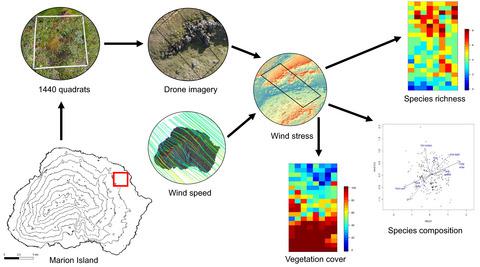Our official English website, www.x-mol.net, welcomes your
feedback! (Note: you will need to create a separate account there.)
Exposing wind stress as a driver of fine‐scale variation in plant communities
Journal of Ecology ( IF 5.3 ) Pub Date : 2021-02-13 , DOI: 10.1111/1365-2745.13625 Mia Momberg 1 , David W. Hedding 2 , Miska Luoto 3 , Peter C. le Roux 1
中文翻译:

暴露风压是植物群落细微变化的驱动力
更新日期:2021-02-13
Journal of Ecology ( IF 5.3 ) Pub Date : 2021-02-13 , DOI: 10.1111/1365-2745.13625 Mia Momberg 1 , David W. Hedding 2 , Miska Luoto 3 , Peter C. le Roux 1
Affiliation

|
- The effects of temperature and precipitation, and the impacts of changes in these climatic conditions, on plant communities have been investigated extensively. The roles of other climatic factors are, however, comparatively poorly understood, despite potentially also strongly structuring community patterns. Wind, for example, is seldom considered when forecasting species responses to climate change, despite having direct physiological and mechanical impacts on plants. It is, therefore, important to understand the magnitude of potential impacts of changing wind conditions on plant communities, particularly given that wind patterns are shifting globally.
- Here, we examine the relationship between wind stress (i.e. a combination of wind exposure and wind speed) and species richness, vegetation cover and community composition using fine‐scale, field‐collected data from 1,440 quadrats in a windy sub‐Antarctic environment.
- Wind stress was consistently a strong predictor of all three community characteristics, even after accounting for other potentially ecophysiologically important variables, including pH, potential direct incident solar radiation, winter and summer soil temperature, soil moisture, soil depth and rock cover. Plant species richness peaked at intermediate wind stress, and vegetation cover was highest in plots with the greatest wind stress. Community composition was also related to wind stress, and, after the influence of soil moisture and pH, had a similar strength of effect as winter soil temperature.
- Synthesis. Wind conditions are, therefore, clearly related to plant community characteristics in this ecosystem that experiences chronic winds. Based on these findings, wind conditions require greater attention when examining environment–community relationships, and changing wind patterns should be explicitly considered in climate change impact predictions.
中文翻译:

暴露风压是植物群落细微变化的驱动力
- 温度和降水的影响以及这些气候条件的变化对植物群落的影响已得到广泛研究。然而,尽管潜在地也可能强烈地构建社区格局,但其他气候因素的作用却知之甚少。例如,尽管风对植物有直接的生理和机械影响,但在预测物种对气候变化的响应时却很少考虑风。因此,重要的是要了解不断变化的风况对植物群落的潜在影响的程度,特别是考虑到风向在全球范围内变化。
- 在这里,我们使用来自南极大风环境中1,440个样方的精细,实地收集的数据,研究了风应力(即风和风速的组合)与物种丰富度,植被覆盖度和群落组成之间的关系。
- 即使考虑了其他潜在的生理生态重要变量,包括pH值,潜在的直接入射太阳辐射,冬季和夏季土壤温度,土壤湿度,土壤深度和岩石覆盖率,风应力也始终是所有这三个群落特征的有力预测指标。在中度风胁迫下,植物物种丰富度达到顶峰,在风应力最大的样地中,植被覆盖度最高。群落组成也与风应力有关,并且在土壤水分和pH影响后,其强度与冬季土壤温度具有相似的强度。
- 综合。因此,风力条件显然与经历长期风的该生态系统中的植物群落特征有关。基于这些发现,在检查环境与社区之间的关系时,需要特别注意风况,并且在气候变化影响预测中应明确考虑风向的变化。











































 京公网安备 11010802027423号
京公网安备 11010802027423号